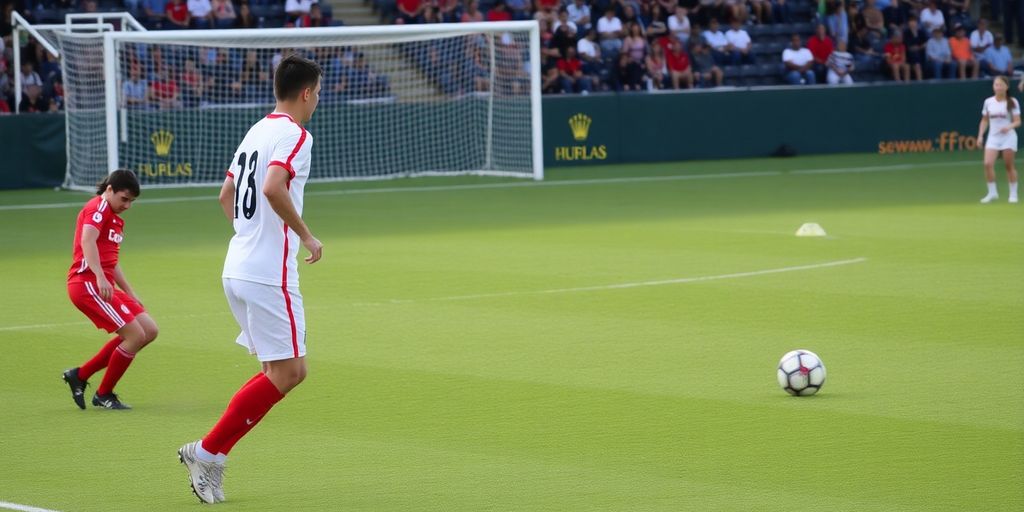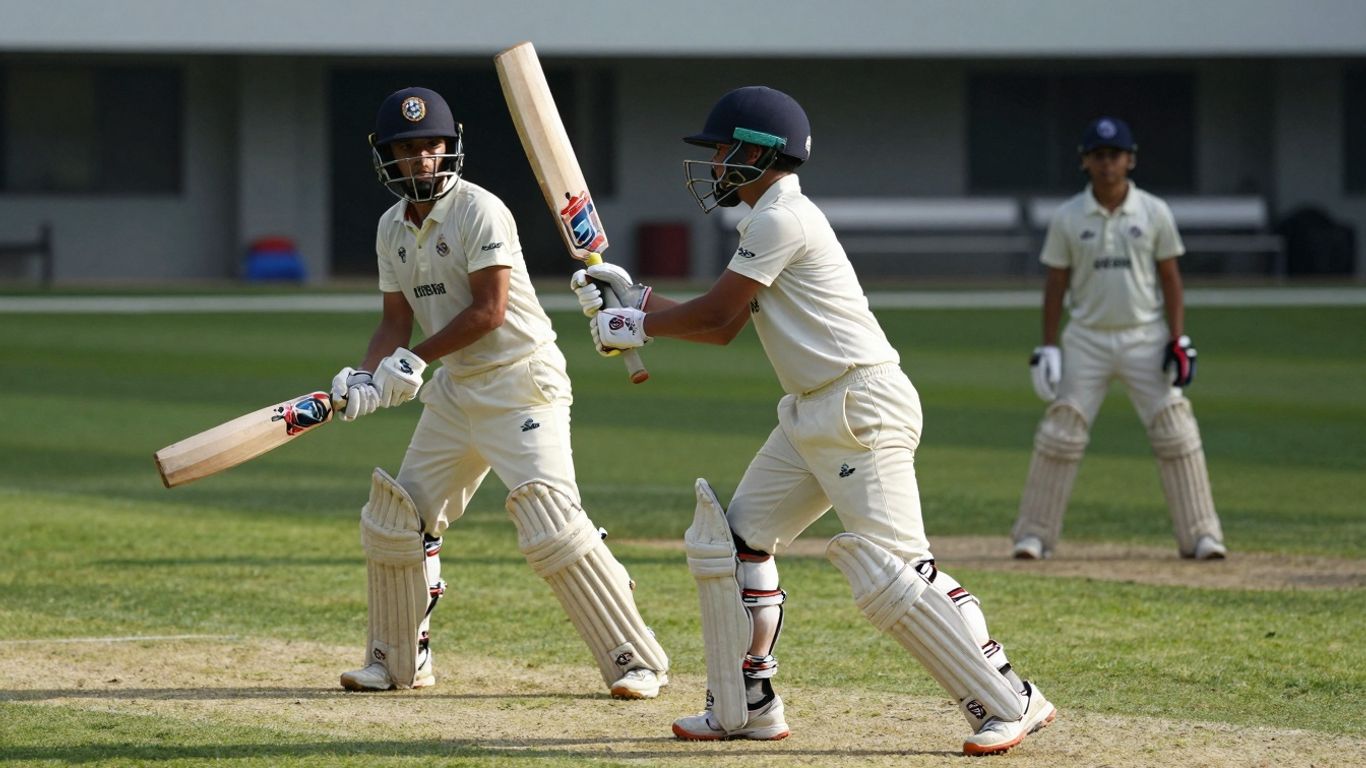Right then, let’s have a yarn about soccer’s offside rule. It’s one of those things that can leave you scratching your head, even after years of watching the game. We’ll break down what it is, why it’s there, and clear up some of the confusion around this tricky bit of soccer rules offside.
Key Takeaways
- An attacker is in an offside position if they are closer to the opponent’s goal than both the ball and the second-last opponent when the ball is played to them.
- An offside offence only happens if a player in an offside position becomes actively involved in play.
- The rule stops players from just hanging around the opponent’s goal, making the game fairer and more exciting.
- Linesmen are primarily responsible for spotting offside, with VAR offering a second look in professional matches.
- Common mix-ups include thinking being ahead of the ball automatically means you’re offside, when active involvement is key.
Understanding The Offside Rule
Right then, let’s get stuck into the offside rule. It’s one of those things in soccer that can leave you scratching your head, but honestly, once you get the hang of it, it’s not too bad. It’s basically there to stop players from just hanging around the opponent’s goal waiting for a pass, which would be a bit boring, wouldn’t it?
What Constitutes An Offside Position?
So, to be in an offside position, you need to be closer to the opponent’s goal line than both the ball and the second-last opponent. The second-last opponent is usually a defender, but it can also be the goalkeeper if they’re further up the pitch. You’re only in an offside position if you’re in the opponent’s half of the field. If you’re in your own half, you can’t be offside, no matter where you are relative to the defenders or the ball.
The ‘Two Opponent’ Principle
This is the key bit, really. When the ball is played to you, there must be at least two opposing players between you and the opponent’s goal line. Most of the time, this will be the goalkeeper and one defender. But remember, it’s the second-last opponent. So, if there are three defenders and the keeper, and you’re ahead of the third defender but behind the second, you’re fine. It’s all about that number two.
When Is An Offside Offence Committed?
Being in an offside position isn’t an offence on its own. You only get penalised if you’re in an offside position and you become actively involved in the play. This means interfering with an opponent, gaining an advantage by being in that position, or playing the ball. If you’re in an offside position but the ball goes to a teammate who is behind you, or you don’t touch the ball or affect the game in any way, then you’re not offside. It’s a bit like being caught looking at the cookie jar – you’re only in trouble if you actually take a cookie. You can read more about the laws of the game if you’re keen.
It’s important to remember that the attacker’s body parts that can score goals are what count for offside. So, your arms and hands don’t factor into it, even though you can’t score with them anyway. It’s all about your head, torso, and feet being in the right place.
Key Elements Of The Offside Law

Player Position Relative To The Ball
When we’re talking about offside, it’s not just about where you are on the field, but where you are when the ball is actually played by your teammate. You could be standing right next to the opposition’s goal, but if the ball is still behind you when your mate kicks it, you’re sweet. It’s all about that moment the ball leaves your teammate’s foot. If you’re already ahead of the second-last defender at that exact instant, then you’re in an offside position. Simple as that, really.
The Role Of The Second-Last Opponent
This is the big one, the key to figuring out if someone’s offside. You need to have at least two opposition players between you and the goal line when the ball is played. Usually, one of those players is the goalie, and the other is a defender. But it can be any two players. If you’re closer to the opponent’s goal than the second-last defender, and you’re involved in the play, you’re offside. It’s like a little game of ‘stay behind the line’ for attackers. Getting this right is pretty important for understanding the whole shebang. It’s a bit like trying to get your finances in order before buying a house; you need to know the basics first, like understanding your budget understanding your budget.
When The Rule Does Not Apply
Now, it’s not always offside, even if you’re ahead of the defenders. There are a few situations where the rule doesn’t come into play. For starters, if you receive the ball directly from a goal kick, a throw-in, or a corner kick, you can’t be offside. Also, if you’re in your own half of the field when the ball is played to you, you’re fine, no matter where the defenders are. And remember, you’ve got to be actively playing the ball or interfering with an opponent to be penalised. Just hanging out in an offside position isn’t enough on its own.
Why The Offside Rule Exists

So, why do we even have this offside rule in soccer? It’s not just to make commentators sweat, you know. Basically, it’s all about keeping the game fair and interesting. Without it, you’d probably see forwards just parking themselves right next to the opposition’s goal, waiting for a long ball. That’s not exactly thrilling viewing, is it?
Preventing ‘Goal Hanging’
Imagine a game where strikers just hang out by the opponent’s goal the entire match. It’d be pretty boring, and the defenders would have a shocker trying to mark players who aren’t even trying to play the ball. The offside rule stops this ‘goal hanging’ by making sure attackers have to be involved in the play and can’t just wait for an easy tap-in. It keeps everyone on their toes and makes sure the game flows properly. It’s a bit like preventing players from camping in a video game – it ruins the fun for everyone else.
Ensuring Fair Play And Excitement
This rule is a big part of what makes soccer so dynamic. It forces teams to think about their positioning and how they build attacks. If you’re too far forward when the ball is played, you’re penalised. This means you can’t just have one or two players miles ahead of everyone else. It encourages teamwork and makes sure that scoring a goal is a result of good play, not just being in the right place at the wrong time. It adds a layer of strategy that keeps things exciting for us watching.
Strategic Depth In Soccer
Honestly, the offside rule adds a whole heap of tactical thinking to the game. Coaches spend ages working on defensive shapes and how to catch opposition attackers offside. It’s a constant battle of wits between the attackers trying to find space and the defenders trying to stay organised. You see teams push their defensive line up to catch attackers out, or attackers try to time their runs perfectly. It’s a really clever bit of lawmaking that makes the game more complex and, dare I say, more enjoyable to watch. It’s not just about kicking a ball; it’s about positioning, timing, and outsmarting your opponent.
Offside Decisions And Match Officials
Making the right call on offside can be a real head-scratcher, can’t it? It’s not just about who’s where, but when the ball was actually played. That’s where the match officials come in, and they’ve got a tough gig.
The Linesmen’s Crucial Role
Linesmen, or assistant referees as they’re officially known, are the ones with the best view of the offside lines. They’re positioned along the touchline, keeping a close eye on attackers and defenders. Their flag is the first indication of an offside call. It’s a high-pressure job, as even a slight misjudgment can change the course of a game. They’re trained to spot players being in an offside position when the ball is played, and then whether they become involved in the play. It’s a bit like trying to catch a fly in a hurricane sometimes.
Understanding Referee Signals
When a linesman flags for offside, they’re not just waving their flag about. They’ll raise it, and if the ball is out of play, the referee will acknowledge it. If the ball is still in play, the linesman will wait for the play to stop or for the attacking team to lose possession before signalling. The referee then makes the final decision, often consulting with the linesman. A common signal is the linesman pointing their flag down the field in the direction play is continuing, indicating the offside offence occurred in that area. It’s a bit of a dance between the officials to get it right.
The Impact Of VAR On Offside Calls
Now, with Video Assistant Referees (VAR), things have gotten even more interesting, and sometimes, a bit more controversial. VAR can review offside decisions, especially those leading to goals. They use multiple camera angles to get a super close look, sometimes down to the millimetre. This has led to some goals being disallowed for the tiniest of infringements, which can be frustrating for fans and players alike. It’s meant to improve accuracy, but it definitely adds another layer of scrutiny to the game. The debate about whether a player is offside or not, even with all the technology, is still a hot topic. It’s changed how we look at the second last defender and their role in the offside equation.
Common Misconceptions About Offside
Righto, let’s clear up some of the stuff people get wrong about offside. It’s not as complicated as some make it out to be, but there are definitely a few common traps.
Being Ahead Of The Ball
This is a big one. Loads of people think if you’re just in front of the ball when it’s played, you’re offside. That’s not quite right. You can be ahead of the ball, no worries at all. The key thing is where you are in relation to the second-last defender (and the ball, of course) at the exact moment your teammate plays the pass. If you’re level with or behind that defender, you’re sweet. Being ahead of the ball itself doesn’t automatically mean you’ve broken the rule. It’s all about that defensive line.
The Importance Of Active Play
Just being in an offside position isn’t an offence. You’ve actually got to be involved in the play. This means interfering with an opponent, gaining an advantage by being in that position, or playing the ball. So, if you’re miles offside but just standing there watching the play unfold without touching the ball or bothering anyone, you’re technically not offside. It’s when you get involved that the whistle blows. Think of it like this:
- Interfering with an opponent: Blocking their vision or making them change their movement.
- Gaining an advantage: Getting to a rebound or a loose ball that you wouldn’t have reached if you weren’t offside.
- Playing the ball: The most obvious one – touching the ball.
Arm vs. Body Position
Another common mix-up is what part of your body counts. The rules are pretty clear on this: only certain parts of your body can be used to be ‘on’ or ‘off’side. Your arms and hands don’t count for offside decisions. So, if your arm is sticking out a bit further than the last defender, but the rest of your body is behind them, you’re fine. It’s your head, torso, or feet that matter. It’s a bit like trying to get the best spot at barefoot bowls in Sydney – you need to be in the right place with the right bits!
The rule is designed to stop players just hanging around the opposition’s goal waiting for a cheap goal. It keeps the game moving and requires a bit of smarts from attackers to time their runs.
Potential Future Changes To Offside
The offside rule, as we know it, has been around for ages, but there’s always talk about tweaking it to make the game even better. You know, keeping things fair but also exciting. It’s not just about stopping players from hanging around the goal, but also about how the game flows.
Arsene Wenger’s Proposed Adjustments
Former Arsenal manager Arsene Wenger, who’s been a big name in football development, has put forward some ideas to change the offside law. One of his main thoughts is to make it so a player isn’t offside if any part of their body that can score a goal is level with the second-last defender. Right now, it feels like even a tiny bit of an attacker being ahead means they’re offside, and Wenger reckons this is a bit too strict. He thinks his change would make defenders have to push up higher, which could open up the game more. It’s a pretty big shift from the current, super-precise way of calling offsides. Imagine if a player’s toe is level with the defender, but the rest of them is ahead – under Wenger’s idea, that’s play on!
The ‘Onside’ Advantage for Attackers
This proposed change would definitely give attackers a bit more freedom. It means they could time their runs a bit differently, maybe taking more risks to get into scoring positions. The idea is that if there’s any doubt, or if the attacker is level, they get the benefit. It’s a bit like saying, ‘If you’re not clearly ahead, you’re onside.’ This could lead to more goals and maybe even change how teams defend, forcing them to stay tighter and not leave any gaps. It’s all about trying to keep the game moving and giving attacking players a bit more of a fair go, especially when VAR is scrutinising every millimetre. It’s a bit like trying to get a better deal on stamp duty in NSW; you want the best outcome for yourself.
Impact of Rule Modifications
Changing the offside rule could have some pretty big ripple effects. For starters, we might see more attacking football, with teams pushing higher up the pitch. This could lead to more goals, but it might also mean more space in behind for counter-attacks. Defenders would have to be super sharp and organised. It’s a bit like trying to manage your finances; you need a clear strategy. We could also see a shift in tactics, with teams perhaps playing a more aggressive, high-pressing game. It’s all part of the ongoing discussion about how to keep soccer fresh and engaging for everyone watching. The game is always evolving, and these discussions about offside are just part of that.
So, That’s Offside, Then?
Right then, we’ve had a good yarn about the offside rule. It’s not as complicated as it first seems, is it? Just remember, if you’re closer to the other team’s goal than the second-last defender when the ball’s played, and there aren’t at least two opponents between you and the goal line, you’re probably offside. It’s all about keeping the game fair and stopping players from just hanging around the goal waiting for a cheap one. Give it a bit of thought next time you’re watching or playing, and you’ll see it makes sense. It’s just another part of what makes soccer the game it is.
Frequently Asked Questions
So, what’s the deal with being offside?
Basically, you’re offside if you’re closer to the other team’s goal than both the ball and the second-last opponent (usually a defender) when the ball is played to you. You need at least two opponents between you and the goal to be onside. It’s a bit like a rule to stop players just hanging around the goal waiting for a chance, keeping the game fair and exciting.
If I’m ahead of the last defender, am I always offside?
Nah, not always! You can be in an offside position but not be penalised if you’re not actually involved in the play. For example, if you’re offside but the ball goes to a teammate who is onside, or if you don’t touch the ball or interfere with an opponent, you’re usually fine. It’s all about being actively involved when you’re in that tricky spot.
What part of my body counts for being offside?
It’s a bit tricky, but generally, it’s any part of your body that you can score with – so your feet, head, or chest. Your arms and hands don’t count for this purpose. So, if your foot is level with the defender, you’re onside, even if your head is ahead.
Who decides if someone is offside?
The linesmen, who are the officials on the sidelines, are the main ones who call offside. They watch the play closely and raise their flag if they see an offside offence. The referee then makes the final decision based on the linesman’s call and what they see themselves.
Why does the offside rule even exist?
The offside rule was brought in to stop players from just loitering near the opponent’s goal, waiting for a long pass. This ‘goal hanging’ would make scoring too easy and take the excitement out of the game. It encourages more flowing play and makes sure everyone has to work to create chances.
Are there any ideas to change the offside rule?
Some clever folks, like Arsene Wenger, have suggested changes to make it fairer for attackers. One idea is that if any part of your body that you can score with is level with the last defender, you’re considered onside. This would give attackers a bit more freedom and might lead to more goals, but it’s still being debated!





